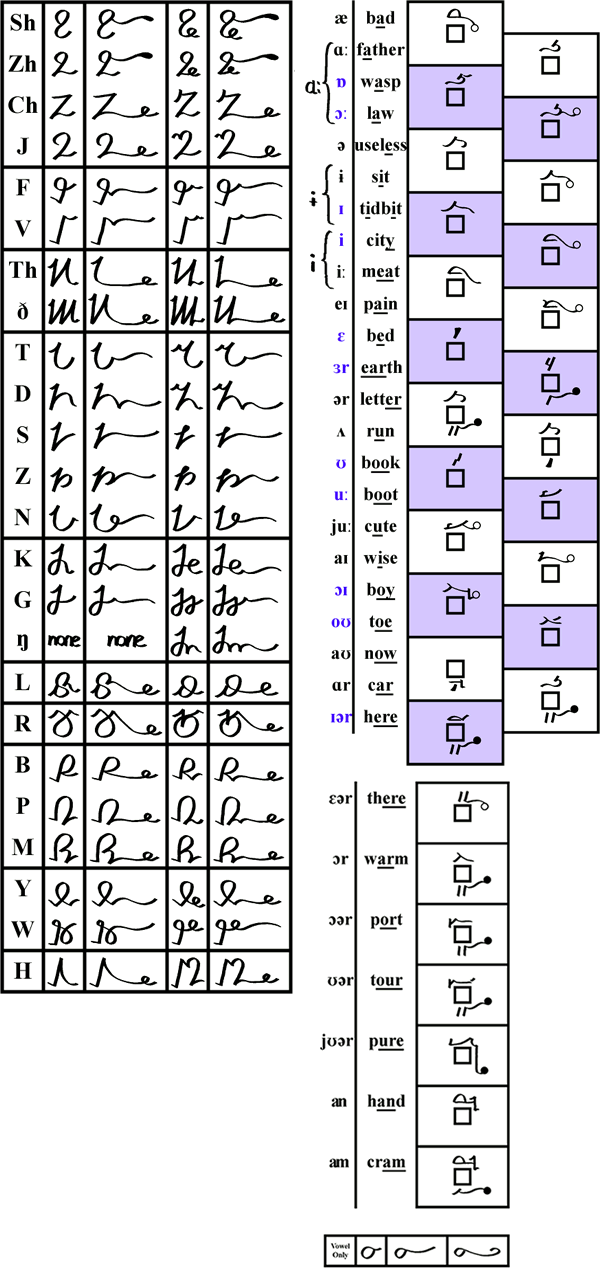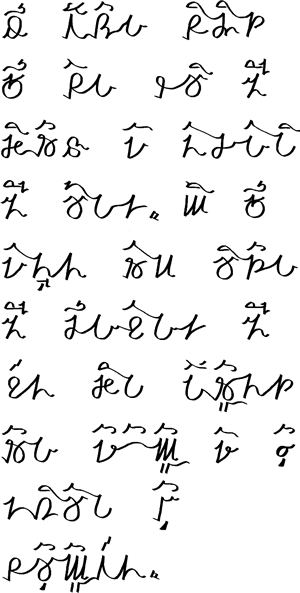
The Sequoia writing system was invented by Devin Hill in his free time as a high school student, over the course of several weeks. It was designed to have a flowing aesthetic, and be generally visually appealing. It is an abjad used to write English phonetically, in which all vowels are diacritics, and must be written. Though it was not modeled after any specific other language or script, the most influential script on its appearance is Arabic.
Below is a chart of the 24 basic consonant sounds of English, expressed via their commonly associated letters and grouped according to their similarity of sound. Accompanying them are four symbols each, these being the four forms each consonant may take, in order:

As you may notice, consonants' beginning stroke starts always at either the top or bottom. This is important later.
The vowels are written as a set of 30 diacritics, which may connect to the consonant following in certain conditions, and are to be drawn around the consonant, as represented by the square. The vowels' IPA symbols are in blue or black to help distinguish between the columns more easily. The vowels associated with the IPA symbols are given an English word representing the sound properly, and then are shown in alternating columns to the right. The markings to the side indicate that if one is unsure which of the surrounded vowels to pick, he should default to the one written outside the bracket.
The last 7 vowel sounds, and the "empty" consonant, are used for words which consist of only vowel sounds. The three forms correspond to one, two, and three vowel sounds respectively (though the final may never need to be used, who knows).

All human beings are born free and equal in dignity and rights.
They are endowed with reason and conscience and should act towards
one another in a spirit of brotherhood.
(Article 1 of the Universal Declaration of Human Rights)
The sample text was written with connections between adjacent consonants if they ended and began at similar heights and were not connected to a vowel.
Unfortunately, due to the complexity of the script, there are no fonts, although any future endeavors to do so are certainly welcome.
Constructed scripts for: Ainu | Arabic | Chinese languages | Dutch | English | Hawaiian | Hungarian | Japanese | Korean | Lingala | Malay & Indonesian | Persian | Tagalog / Filipino | Russian | Sanskrit | Spanish | Taino | Turkish | Vietnamese | Welsh | Other natural languages | Colour-based scripts | Tactile scripts | Phonetic/universal scripts | Constructed scripts for constructed languages | Adaptations of existing alphabets | Fictional alphabets | Magical alphabets | A-Z index | How to submit a constructed script
[top]
You can support this site by Buying Me A Coffee, and if you like what you see on this page, you can use the buttons below to share it with people you know.

If you like this site and find it useful, you can support it by making a donation via PayPal or Patreon, or by contributing in other ways. Omniglot is how I make my living.
Note: all links on this site to Amazon.com, Amazon.co.uk
and Amazon.fr
are affiliate links. This means I earn a commission if you click on any of them and buy something. So by clicking on these links you can help to support this site.
[top]